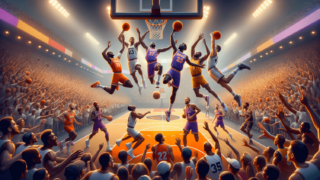
Welcome to our ultimate guide on how to create your very own basketball card! In the following article, we’ll delve deep into the world of basketball card making, capturing the passion and excitement of your favorite sport in a timeless, personal piece of memorabilia. Whether you’re a seasoned collector, a young baller looking to celebrate their achievements, or simply a die-hard basketball aficionado, we’ve got you covered. So tighten your shoelaces, grab your trusty basketball, and get ready to discover the ins and outs of immortalizing your favorite moments, players, and memories on the court through the captivating art of basketball card creation.
How to Make a Basketball Card?
To make a basketball card, follow these steps: 1) Choose your subject, whether it’s a professional player, yourself, or a friend; 2) Gather high-quality images capturing action shots, portraits, or poses; 3) Select the card dimensions, typically 2.5″ x 3.5″ for a standard size; 4) Design the card layout, including background, borders, and fonts; 5) Add key stats, such as points, rebounds, assists, and shooting percentages; 6) Include personal or biographical information, like name, position, and team; 7) Proofread your work to ensure accuracy and visual appeal; and finally, 8) Print the card with a professional service or at home using high-quality paper or cardstock.
Step 1: Choose Your Basketball Card Subject
Whether you’re a die-hard fan of a specific player or team, an up-and-coming talent, or just want to celebrate your own on-court accomplishments, the primary step in creating a basketball card is selecting your subject. Your choice can dictate the overall design and appeal of your card, so put some thought into it! Can’t decide which player to showcase? One option is to create multiple basketball cards, turning your idea into a series or a themed collection.
Step 2: Gather High-Quality Images
A picture speaks a thousand words, and when it comes to basketball cards, the imagery is the centerpiece. Start by browsing the internet for professional-quality photographs of your chosen subject. Ideally, gather a mix of action shots, portraits, and team poses that best represent your player. Remember to respect copyright laws, and always credit the photographer or source when required. For personalized cards, consider scheduling a photo session with a local photographer to get the perfect shot.
Tips for Choosing the Perfect Image:
- High-resolution photos: Opt for images with a minimum resolution of 300 dpi for optimal print quality.
- Consider composition: Choose photographs that highlight the player’s strengths, such as a dexterous dribble or an impressive slam dunk.
- Think about lighting: Look for images with ample natural or artificial light, which can enhance the overall visual appeal of the card.
- Pay attention to background: A clutter-free, well-balanced background can make your subject stand out on the card.
Step 3: Select Your Basketball Card Dimensions
Next, determine the size of your basketball card. While the standard trading card size is 2.5″ x 3.5″ (63.5mm x 88.9mm), you can explore other dimensions to give your card a unique touch. Factors to consider when deciding on size include storage options, the amount of information you wish to include, and the desired impact on the card’s overall presentation. Remember that larger cards can accommodate more details, but smaller ones may be easier to store and showcase in popular trading card sleeves and albums.
Step 4: Designing Your Basketball Card Layout
Now that you have your subject, high-quality images, and card dimensions at the ready, it’s time to design the card layout. A visually appealing, well-organized layout is essential in bringing your basketball card to life. For a professional look, you can use software such as Adobe Photoshop, Illustrator, or online design tools like Canva. Alternatively, you can seek the help of a graphic designer to execute your vision.
Key Elements for Your Card Layout:
- Background: Choose colors, patterns, or subtle images that complement the focal image and enhance the card’s overall visual appeal.
- Borders: Find the perfect balance between eye-catching borders and clean lines to ensure the content is easily readable.
- Fonts: Pick one or two fonts that match your card’s theme and style. Ensure your text is legible and doesn’t overpower the imagery.
- Logo and branding: Incorporate your personal logo or team branding to create a basketball card with a cohesive and authentic look.
Step 5: Incorporating Essential Basketball Stats
A basketball card is more than just a visual representation of your chosen subject – it’s also an opportunity to showcase their skills and achievements on the court. Add key statistics like points per game, rebounds, assists, shooting percentages, and more to highlight the player’s performance. Make sure to include season and career stats, as well as any notable awards and recognitions. Well-rounded and accurate stats can further enhance the value and appeal of your basketball card.
Step 6: Include Personal or Biographical Information
To give your basketball card an additional layer of depth, include personal or biographical information about your subject. Adding the player’s name (or nickname), position, team, and height is standard for most basketball cards. If space allows, you can also include more unique details, like the player’s college, draft year, hometown, or an interesting fact. Whether serious or fun, personal tidbits can offer a captivating glimpse into the player’s life beyond the court.
Step 7: Proofread and Revise
Before printing your basketball card, it’s essential to proofread and revise your work. Check your card for any typos, inaccuracies, or inconsistencies in the stats and text. Verify that images are cropped and aligned correctly, confirm that the color palette is consistent, and double-check that your chosen fonts are legible at the card’s intended size. Asking a trusted friend or colleague to review the card can provide valuable feedback and catch any potential errors you may have missed.
Step 8: Print Your Basketball Card
With your proofread and perfected basketball card design, it’s time to bring it to life with a high-quality print. There are two primary options for printing your basketball cards:
Professional Printing Services:
For the best results, turn to a professional printing service that specializes in trading cards or similar products. They can guide you on the ideal cardstock, lamination, and finish to achieve the desired look and feel for your card. Plus, with their expertise and cutting-edge equipment, you can expect a polished, professional product.
Home Printing:
If you prefer a DIY approach, home printing can be a viable alternative. Invest in a high-quality color printer, and choose a suitable cardstock or glossy photo paper for your basketball card. Be prepared for some trial and error, adjusting your printer settings to achieve the best results. And remember – cutting your cards with precision is crucial for ensuring that crisp, professional appearance.
In the end, the process of creating a basketball card is a labor of love, driven by your passion for the sport and the players who bring it to life. By following these steps, you’ll soon be holding your very own, personalized piece of basketball memorabilia that you can proudly showcase or trade with fellow enthusiasts. Happy card-making!
Bonus Tips: How to Further Enhance Your Basketball Card
Creating a memorable basketball card doesn’t end with design and printing. To truly stand out, consider these bonus tips that can elevate your basketball card to the next level:
Add Autographs or Signatures
An autograph from the featured player can significantly boost the appeal and value of your basketball card. If you have access, ask the player to sign the card using a high-quality, permanent marker in a complementary color. For personalized cards, consider adding your own signature or a signed message to friends and family.
Consider Limited Editions and Serial Numbers
If you’re creating a series or collection of basketball cards, think about making them limited editions by assigning serial numbers. For example, “1/50” would indicate the first card in a limited run of 50. This can create a sense of exclusivity and increase the perceived value of your card among collectors.
Protect and Store Your Basketball Cards Properly
Once you’ve created your basketball card, protect it from wear and tear by storing it in clear, plastic sleeves, top-loaders, or screw-down cases. If you have several cards, invest in a high-quality binder or display case to showcase your collection. Proper storage helps maintain the card’s condition and can prolong its lifespan.
Market Your Basketball Card
If you plan to sell or trade your basketball cards, it’s important to market them effectively. Share your cards on social media, join collector forums or trading card groups, and attend hobby conventions to connect with fellow enthusiasts. A well-executed marketing strategy can create buzz around your basketball cards and pique the interest of potential buyers or traders.
Stay Informed About Basketball Card Trends
Immerse yourself in the world of basketball card collecting by staying informed about current trends and popular players. Regularly read blogs, listen to podcasts, and engage in discussions with other collectors. This knowledge can help you make informed decisions when designing and collecting basketball cards that may be particularly valuable or appealing to others.
By incorporating these additional tips, you’ll not only create visually stunning and meaningful basketball cards, but also increase their potential value and appeal in the ever-evolving world of card collecting. Keep exploring, learning, and pushing the boundaries of creativity – and most importantly, have fun with the process!
Frequently Asked Questions (FAQ) about Making Basketball Cards
Now that you have a solid grasp on creating basketball cards, you might have some additional questions along the way. This FAQ section covers some common queries, providing concise answers to help deepen your understanding of the basketball card creation process.
1. Can any image be used for a basketball card?
Choose high-quality, high-resolution images that capture the essence of your subject. Always respect copyright laws and give credit to the photographer or source when required. For personalized cards, consider booking a professional photo session.
2. What materials are best for printing basketball cards?
For optimal results, use a high-quality cardstock or glossy photo paper. Additionally, you can consult with professional printing services for advice on the best materials and finishes for your basketball cards.
3. How do I determine the value of my basketball card?
Valuing basketball cards relies on factors such as the player’s popularity, rarity of the card, condition, autographs, and card production year. Websites, trading card forums, and price guides can offer insights and comparables to help determine your card’s potential value.
4. What are some popular companies that print trading cards?
Some popular companies that print trading cards include Upper Deck, Panini America, Cardboard Gold, and Topps. Each company may have different printing options and services, so explore and compare to find the best fit for your basketball card.
5. How do I properly cut basketball cards at home?
To achieve a clean, professional finish, use a precision cutting tool like a paper cutter, craft knife, or rotary cutter, along with a ruler and a cutting mat. Another option is to purchase pre-cut cardstock that matches the dimensions of your basketball card.
6. Can I make digital basketball cards?
Yes, creating digital basketball cards has become increasingly popular. You can share your digital cards online, via social media, or even incorporate them into mobile apps for digital collecting and trading.
7. How can I prevent my home-printed cards from fading?
Protect your printed cards from sunlight and store them in a cool, dry place. Additionally, you can use UV-resistant or archival-quality sleeves, top-loaders, or screw-down cases to preserve the card’s condition.
8. Can I make basketball cards for profit?
It is possible to make basketball cards for profit, but factors like player popularity, card design, and production quality play a significant role in determining the card’s market value. To increase the chances of generating a profit, stay informed about basketball card trends and current market demands.
9. What software options are available for designing basketball cards?
Adobe Photoshop and Illustrator are popular choices, as are online design tools like Canva. Even open-source software like GIMP or Inkscape can be utilized to create compelling basketball card designs.
10. How can I make a basketball card template?
Create a template using design software or online tools. Set up guides, layers, and style presets to establish a consistent layout for multiple cards. A well-designed template can save time and create a uniform look for your card series or collection.
11. What information should I include on the back of a basketball card?
Typically, the back of a basketball card contains player stats, biographical details, and personal tidbits. You can also add trivia, a short player profile, or a brief description of the card’s featured image.
12. How do I ensure my basketball cards have consistent print quality?
Consistent print quality can be achieved by using high-resolution images, calibrating your printer settings (for home printing), or working with a professional printing service that specializes in trading cards.
13. Are digital signatures valuable on basketball cards?
Digital signatures are becoming more accepted in the trading card community, especially as card collecting incorporates digital platforms. While a digital signature may have some value, traditional ink signatures are often considered more valuable and authentic.
Featured Posts
- No pillar pages found.





